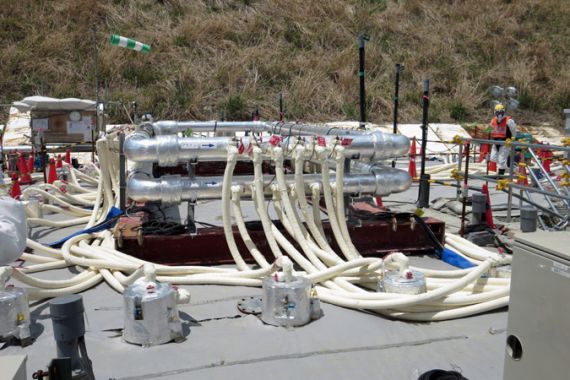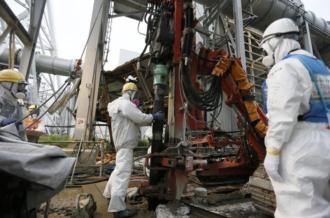Freezing out Fukushima’s radioactive water
Japanese engineers face mammoth task of dealing with contaminated water from the nuclear plant disaster.

Tokyo, Japan – It’s been more than three-and-a-half years since the earthquake and tsunami that rocked northern Japan in March 2011, crippling the Fukushima Daiichi nuclear power plant, a disaster that continues to unfold to this day.
Engineers at the Tokyo Electric Power Company (TEPCO), which owns the plant, still have a mammoth task in front of them: How to deal with millions of litres of water full of radiation resulting from the catastrophe.
Keep reading
list of 4 itemsAfter the Hurricane
World’s coral reefs face global bleaching crisis
Why is Germany maintaining economic ties with China?
The plant site, badly damaged by hydrogen explosions and reactor core meltdowns after the earthquake and tsunami, is glutted with steel storage tanks filled to capacity with contaminated water pumped out of the reactor facilities.
More than 1,000 tanks clog the site, and empty ones are being filled daily. As of September 23, the total volume of water stored had reached 583,000 tonnes, according to the Ministry of Economy, Trade and Industry (METI).
These tanks require regular monitoring, as leaks have occurred in the past, causing hundreds of tonnes of polluted water to spill out, some of it into the sea.
 |
| Workers construct an ice wall attempting to freeze highly radiated water [EPA] |
This watery nightmare is a result of the plant’s location at the bottom of a hillside, between mountains and the Pacific Ocean. When it rains, much of the precipitation soaks into the soil, becomes groundwater, and runs downhill towards the sea.
Until recently, some 400 tonnes of groundwater flowed into the plant every day, mixing with highly radioactive coolant water collecting in the basements of the reactor buildings and adjoining turbine facilities.
To prevent the radiated water from running into the sea, TEPCO constantly pumps it out of the basements to a temporary storage facility. From there it passes through a water-decontamination system to remove caesium radionuclides.
The treated water is further processed through a desalination system, and a Toshiba-designed Advanced Liquid Processing System (ALPS) – that extracts more of the remaining multi-nuclides – before it is pumped into the storage tanks.
At the same time, TEPCO is injecting an additional 320 tonnes of partly cleansed and cooled water daily into the damaged reactor pressure vessels containing the melted nuclear cores to keep them from overheating. During the process, the water becomes contaminated and escapes through the damaged parts of the pressure and outer containment vessels and ends up in the basements, where it mixes with the incoming groundwater.
Stopgap battle
At best, then, TEPCO is fighting a stopgap battle just to maintain the status quo – a battle that has continued for the past three-and-a-half years.
|
|
| Fukushima ‘ice wall’ sparks serious concerns |
The government has finally acknowledged the futility of this finger-in-the-dike operation, and last year it stepped in to oversee the plant’s decommissioning.
“This decommissioning process is unprecedented. So we’ve solicited help from experts and companies on a worldwide basis,” said an official who spoke only on background.
A number of plans have been devised to deal with the water crisis, the most prominent being the so-called “ice wall”.
TEPCO is preparing to freeze the soil around the four damaged reactor buildings to create an impermeable, 1.5km barrier. “The frozen wall of soil will block the flow of groundwater,” Mayumi Yoshida, a TEPCO official, told Al Jazeera. “The water will then flow around the perimeter and into the sea without becoming contaminated.”
That’s the plan, anyway. In principle, “it is possible to freeze the soil to a certain depth and certain length”, Kazuaki Matsui, executive director of the Institute of Applied Energy, an independent research group in Tokyo, told Al Jazeera. “But I don’t think we have any clear examples of freezing such a long wall, though that doesn’t mean it’s not possible. Certainly it’s going to take a lot of energy [to operate], so it will be costly.”
TEPCO said the technique is similar to that used in constructing ice-skating rinks. It has also been used many times in Japan during road and railway tunnel construction to prevent the intrusion of groundwater.
One observer has expressed scepticism over the plan.
“With the local geology, that’s a very big challenge,” nuclear engineer John Large told Al Jazeera. “I don’t think this is the right way of doing it because it requires continuous feeds, continuous power to keep the ice wall going … This is a temporary solution. What they should do, in my opinion, is put all their technology and thinking into how to actually control, manage, and remove the reactor cores as soon as possible.”
Freezing process ‘on schedule’
In June, the company began drilling the ground and inserting pipes to carry a concentrated saline solution that will circulate at a temperature below -30 degrees Celsius. When completed, “a total of 1,571 vertical pipes will be inserted into the earth at regular intervals”, said Yoshida. “And the freezing process is on schedule to begin in March next year.”
The company is also struggling to prevent contaminated water from entering a trench for pipes and electrical cables that run from the reactor facilities. The trench, which lies between the plant and the seaside, is filled with radiated water and needs to be pumped out to prevent it from overflowing.
|
|
| Nuclear analyst concerned over Fukushima ‘ice wall’ |
Earlier, TEPCO attempted to freeze the water at the gateways leading from the facilities to the trench, but was unsuccessful because the water was moving.
According to TEPCO, engineers are now working to block the gateways with special cement-based sealant and packing. “We’ve now been able to freeze between 80 to 90 percent of the water,” said Yoshida.
A third preventative scheme that is showing some success is a bypass system that TEPCO has built on the hillside above the plant. This involves pumping up groundwater before it drains downhill.
The water is stored locally and tested for possible contamination that could result from rainwater seepage carrying down surface radiation. TEPCO said the stored water is discharged only when it is clean enough to return to the sea.
“This bypass system has reduced the groundwater flow entering the plant site from 400 tonnes to between 320 to 350 tonnes daily,” a METI official told Al Jazeera on condition of anonymity.
A fourth scheme involves constructing a steel barricade between the plant and the existing seawall, to prevent contaminated groundwater seeping from the plant from entering the ocean. It is almost completed and scheduled to be in operation soon.
40-year process
If these schemes prove successful, TEPCO will have breathing space to begin work on fully decontaminating the water in the storage tanks. What it will do with the water after that is under discussion. One possibility is to discharge it into the sea.
Getting control of the water will also enable the company to take a major step forward in the task of decommissioning the plant, which it estimates will take 40 years and cost $15bn.
“If they’re successful in isolating the reactor buildings from the groundwater, TEPCO can investigate the source of the leaks in the containment vessels,” said Matsui.
“Then they can try plugging them.” If that can be accomplished, he said, TEPCO can think about flooding these outer protective vessels with water. This would cool the inner reactor pressure vessels with their nuclear contents, as well as act as a shield against radiation.
The next stage would be to remove the covers of the containment vessels and reactor pressure vessels and assess the damage. A plan could then be devised on to how to remove the damaged nuclear material and debris.
“But that,” said Matsui, “is a long, long way off.”